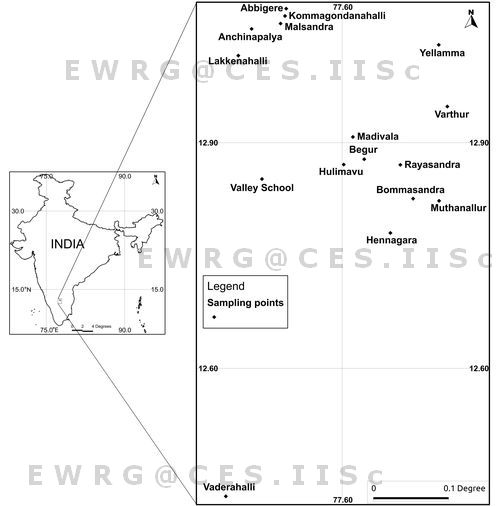|
Materials and Methods
Study area: Bangalore is the capital of Karnataka state and it is located in the heart of south Deccan of Peninsular India (12 58 ' N and 77 35 ' E and at about 920 m above the mean sea level). The climate of the locality is having agreeable temperature ranging from the lowest, 11.4°C (January) to 36.2°C (May). It experiences two rainy seasons from June to September (south west monsoon) and from October to November (north east monsoon). The present study has been carried out in 17 lakes located in three major watersheds of Bangalore - Vrishabavarthy, Koramangla-Challagatta and Hebbal Valley watersheds (Figure 1). Lakes chosen in and around Bangalore city are Anchepalya, Lakkenahalli, Yellamma, Varthur, Abbigere, Kommagondanahalli, Malsandra, Valley School, Nellakondoddi , Vaderahalli, Begur, Hulimavu , Madivala, Rayasandra, Bommasandra, Muthanallur and Hennagara.
Figure - 1: A map showing location of 17 lakes in an around the Bangalore lakes.

Method: Samples of macroinvertebrates were collected at each sampling site using a ‘D’ frame hand net (frame 30 ×30 cm, mesh size 300 μm) disturbing the substrate of littoral zone for 3 minutes covering 1 m2 area with different substrate. Hand picking method was also used in some conditions. The collected macroinvertebrates samples were preserved in 70% ethanol. Organisms were hand-sorted under a stereoscopic microscope, identified with the help of identification manual and literatures (Dudgeon, 1999; Merrit and Cummins, 1994; Subramanian and Sivaramakrishnan, 2005 & 2007). Taxa were assigned to a trophic category based on Merrit and Cummins, 1994; Morse et al., 1994. The physico-chemical parameters like temperature, pH, turbidity dissolved oxygen (DO), free carbon dioxide, etc. were measured at the sampling sites, while other parameters like total hardness, chloride, total alkalinity, chemical oxygen demand (COD), nitrate, phosphate, sodium and potassium were measured in laboratory using standard protocols (APHA 1998).
Data analysis: Species diversity indices such as Shannon-Weiner, Simpson’s, Pielou evenness, and Margaleg were computed to understand a particular biotic community (Chakrabarty and Das, 2006). Shannon-Weiner diversity index helps in species relative abundance, Simpson’s diversity index weighs towards the abundance of the most common species. Pielou evenness index is used for the degree to which the abundances are equal among the species present in a sample or community. Margalef index is having a good discriminating ability and is sensitive to sample size. It is a measure of the number of species present for a given number of individuals. Cluster analysis of Jaccard index of similarity was used to compare both inlet and outlet of 17 lakes based on presence and absence data of macroinvertebrates. ANOVA (one-way analysis of variance) was used to find significant differences between inlets and outlets of each lake. Environmental parameter data (log(x+1)) were transformed and used for principal component analysis (PCA). PCA was applied to relate the relationship between different study sites and physico-chemical variables. Canonical correspondence analysis (CCA) is a multivariate analysis to explain the relationships between macroinvertebrate species assemblages and their environment. It is used as a preliminary analysis for determining whether particular variable influence species diversity and abundance or not. Calculations were done using package PAST version 2.04.
|


